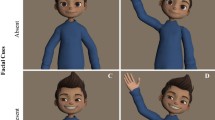Abstract
This project looks at how people approach collaborative interactions with humans and virtual humans, particularly when encountering ambiguous or unexpected situations. The aim is to create natural and accurate models of users’ behaviours, incorporating social signals and indicators of psychological and physiological states (such as eye movements, galvanic skin response, facial expression and subjective perceptions of an interlocutor) under different conditions, with varying patterns of feedback. The findings from this study will allow artificial agents to be trained to understand characteristic human behaviour exhibited during communication, and how to respond to specific non-verbal cues and biometric feedback with appropriately human-like behaviour. Continuous monitoring of “success” during communication, rather than simply at the end, allows for a more fluid and agile interaction, ultimately reducing the likelihood of critical failure.
Access this chapter
Tax calculation will be finalised at checkout
Purchases are for personal use only
Similar content being viewed by others
References
Kang, S., et al.: Does the contingency of agents’ nonverbal feedback affect users’ social anxiety? In: Proceedings of the International Joint Conference on Autonomous Agents & Multiagent Systems-vol. 1 (2008)
Yuen, E.K., et al.: Treatment of social anxiety disorder using online virtual environments in second life. Behav. Ther. 44(1), 51–61 (2013)
Kenny, P., et al.: Building interactive virtual humans for training environments. In: Proceedings of I/ITSEC (2007)
Kim, Y., Thayne, J., Wei, Q.: An embodied agent helps anxious students in mathematics learning. Educ. Tech. Res. Dev. 65(1), 219–235 (2016). https://doi.org/10.1007/s11423-016-9476-z
Rickel, J., Johnson, W.L.: Steve: a pedagogical agent for virtual reality. In: Proceedings of International Conference on Autonomous Agents. ACM Press (1998)
Cassell, J., Sullivan, J., Prevost, S.E.: Embodied Conversational Agents, ed. M. Cambridge. MIT Press (1999)
Dalzel-Job, S., Oberlander, J., Smith, T.J.: Avatars, agency and mutual gaze: effects on eye contact, task performance & perceived social presence. In: Abstracts of European Conference on Eye Movts (2011)
Dalzel-Job, S., Hill, R.L., Petrick, R.: Start making sense: designing likeable, trustworthy and helpful virtual humans. In: Beyond (2019)
Dalzel-Job, S., Hill, R.L., Petrick, R.: Start making sense: predicting confidence in virtual human interactions using biometric signals. In: International Conference on Methods & Techniques in Behavioral Research (2020)
Andrist, S., et al.: Designing effective gaze mechanisms for virtual agents in CHI 2012, Austin, Texas, USA (2012)
Appel, J., et al.: Does humanity matter? Analyzing the importance of social cues and perceived agency of a computer system for the emergence of social reactions during human-computer interaction. In: Advances in HCI, p. 13 (2012)
Bailenson, J.N., et al.: The Independent and Interactive Effects of Embodied-Agent Appearance and Behavior on Self-Report, Cognitive, and Behavioral Markers of Copresence in Immersive Virtual Environments Presence (2005)
Dalzel-Job, S., Nicol, C., Oberlander, J.: Comparing behavioural and self-report measures of engagement with an embodied conversational agent: a first report on eye tracking in Second Life. In: Proceedings of ETRA. ACM.
Dalzel-Job, S., Oberlander, J., Smith, T.J.: Don’t look now: the relationship between mutual gaze, task performance and staring in second life. In: Annual Conference on Cognitive Science (2011)
Dalzel-Job, S.: Social interaction in virtual environments: the relationship between mutual gaze, task performance and social presence. In: Informatics 2015, Edinburgh: Unpublished doctoral dissertation (2015)
Dalzel-Job, S., Oberlander, J., Smith, T.J.: Contested staring: issues & the use of mutual gaze as online measure of social presence. In: ISPR (2011)
Author information
Authors and Affiliations
Corresponding author
Editor information
Editors and Affiliations
Rights and permissions
Copyright information
© 2023 The Author(s), under exclusive license to Springer Nature Switzerland AG
About this paper
Cite this paper
Dalzel-Job, S., Hill, R., Petrick, R. (2023). Start Making Sense: Identifying Behavioural Indicators When Things Go Wrong During Interaction with Artificial Agents. In: Aydoğan, R., Criado, N., Lang, J., Sanchez-Anguix, V., Serramia, M. (eds) PRIMA 2022: Principles and Practice of Multi-Agent Systems. PRIMA 2022. Lecture Notes in Computer Science(), vol 13753. Springer, Cham. https://doi.org/10.1007/978-3-031-21203-1_36
Download citation
DOI: https://doi.org/10.1007/978-3-031-21203-1_36
Published:
Publisher Name: Springer, Cham
Print ISBN: 978-3-031-21202-4
Online ISBN: 978-3-031-21203-1
eBook Packages: Computer ScienceComputer Science (R0)




